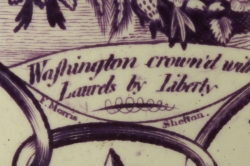 Francis Morris first appears in 1800 [i] as a black printer of Vale Pleasant in the Staffordshire potteries. It is not known whether he was a trained engraver, he may have employed engravers or purchased copper plates from independent engravers. The term black printer was a contemporary term used to describe a printer of overglaze decoration, although other colors were used. By 1809 the firm seems to have expanded and was listed as “Morris, Francis, gilder, enameller, & printer of earthenware, Shelton.”[ii] Little is known of the trading practices of printers in the early nineteenth century, but it is reasonable to suppose that they purchased plain wares to decorate on their own account and decorated wares on commission for manufacturers.
Francis Morris first appears in 1800 [i] as a black printer of Vale Pleasant in the Staffordshire potteries. It is not known whether he was a trained engraver, he may have employed engravers or purchased copper plates from independent engravers. The term black printer was a contemporary term used to describe a printer of overglaze decoration, although other colors were used. By 1809 the firm seems to have expanded and was listed as “Morris, Francis, gilder, enameller, & printer of earthenware, Shelton.”[ii] Little is known of the trading practices of printers in the early nineteenth century, but it is reasonable to suppose that they purchased plain wares to decorate on their own account and decorated wares on commission for manufacturers.
A disproportionate number of Morris pieces exist with designs that suggest Morris specialized in prints for the American market. Unfortunately a renewed outbreak of war between England and France in 1803, resulted in both these countries imposing maritime restrictions eventually creating a continental blockade of trade that affected neutral as well as enemy shipping. America was subject to additional hardship as Britain continued to board her ships and impress seamen into British service. With American honor compromised and maritime trade drastically curtailed, Jefferson’s Embargo Act of 1807 prohibited U.S. ships from trading with Europe and banned the importation of manufactured goods from Britain. Retaliatory trade restrictions imposed by the British increasingly affected not only enemies and neutrals, but damaged British Industry. Economic distress was reported in manufacturing centers throughout Britain and there was a House of Commons Enquiry where evidence was presented to the Government by manufacturers representing British Industry. Britain withdrew their trade restriction with America on June 16, 1812, but it was too late, war had been declared and America and Britain were at war for the second time in less than 50 years. One of the first casualties was Francis Morris whose first notice of bankruptcy was published on 15 August, 1812.[iii]
